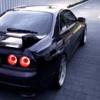Announcements
-
Similar Content
-
Latest Posts
-
Because there is still an engine underneath that turbo. PSI is not a measurement of power, it's a byproduct of resistance. What would be really decent is to have a CFM gauge on the output of a turbo to see how much it's actually pushing. 21psi (as an example) is not the same amount of air at 3000rpm as it is at 7000rpm, even if the boost controller is controlling boost at "21psi". The engine is inhaling and exhaling way more air at 7000 than at 3000, even if it's less efficient.
-
don't want anything more or less, I don't really understand why the torque still goes up to 6000-6500, while the boost peak is around 4000. if it only comes from the cams or from the boost controller etc.
-
I'm not sure you understand the physics of what you are asking. Can you draw on the dyno graph what you want to have happen? I'm thinking this is a functional impossibility here, unless you chose a turbo literally so laggy that torque is at max at 7000rpm and artificially choked prior to that. Power and Torque are intrinsically linked. Power is just Torque over time. What you're really seeing in the torque graph is "Power per RPM" if that makes any sense whatsoever. You still get more power at 7000rpm than 5000rpm, because it is "power per RPM" and you have more RPM. at 7000 than you do at 5000. You still feel more powerful at 7000rpm. The torque graph will influence the rate of power increase per RPM.
-
Welcome! If possible, would live to see some pics. How long was it away getting the work done? Hopefully it feels like a new machine.
-
yes indeed the graphic format makes a visual difference but there is on average 120nm more between 4000 and 6000rpm on the curves it is not nothing. you are right, the cams influence the torque curve. I was able to chat with one of the Hypergear tuners, he confirmed that a boost control allows you to manage the pressure after the spool. the absolute pressure (psi) on the graphics is measured where? It seems that the cams affect the maximum pressure depending on the regime but I may be wrong. not pleasant to drive before 4000? if we spend our lives between 1000 and 3000 rpm as you say then we might as well just run diesel turbos
-






Recommended Posts
Create an account or sign in to comment
You need to be a member in order to leave a comment
Create an account
Sign up for a new account in our community. It's easy!
Register a new accountSign in
Already have an account? Sign in here.
Sign In Now